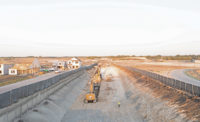"This was the district's first construction manager at-risk project. Our early involvement allowed us to become involved in the design, offering feedback on cost and constructibility for real time numbers," says Garney project manager David Burkhart. "It also allowed us to identify and troubleshoot any gaps for material procurement."
The water district and Garney consequently acquired key materials prior to 100% plan design completion, including 84-in.- and 96-in.-dia C200 cement-mortar-lined polyurethane-coated steel pipe. The project, which broke ground last November, consists of 48 bid packages with a total of about 40 contractors and suppliers. Project segments are being built simultaneously, with 350 workers on site during the peak of construction activity.
"During the predesign stage, there were areas that we were able to identify that saved time and money, such as using an open-cut method for parts of the pipeline alignment as opposed to tunneling," says Garney construction manager Jason Jansen. "Essentially, construction management at-risk enabled us to compress the schedule and finish in half the time."
Massive Piping
The project consists of an 80-acre berm ring dam that serves as a 250-million-gallon balancing reservoir. The earthen geomembrane-lined structure is built using soil cement—a highly compacted mix of aggregate, Portland cement and water—to capture the outflow from Lake Texoma. The reservoir equalizes water for a more uniform flow to the treatment plant via a 100-mgd pipeline that is 100% gravity fed. There is a 350-ft drop in elevation from Lake Texoma to the Wylie water treatment plant.
Construction entails digging an 11-ft-wide, 15-ft-deep pipeline trench with tunnel sections up to 40 ft deep. The length and alignment present workers with diverse geotechnical conditions, from seeping soil to limestone. The job requires nearly 3 million cu yd of excavation, with 20,000 truckloads of aggregate backfill and embankment.
"With the amount of materials on this project, we have a load of something every 7 feet," says Jansen, who estimates there are up to 225 trucks working on the job.
Hanson Pressure Pipe, a unit of Heidelberg Cement Group, and Northwest Pipe Co. will deliver the project's pipeline in 5,000 truckloads. The pipeline trench, which will carry water monitoring fiber optics, delivers raw water to the 770-mgd Wylie plant that is 25 miles outside of Dallas. The plant is undergoing upgrades with 20 new structures to accommodate the pipeline, including the addition of five above-ground concrete wire storage tanks. The largest, which is 56.5 ft tall and 128 ft in diameter, has a 2.7-million-gallon storage capacity.
Sleeve valves reduce the high pressure or throttle flow of incoming raw water. Lake Texoma pipeline water will enter treatment at about 200 psi. There are also cast-in-place and precast tilt-up chemical, electrical and control buildings as well as two mixing boxes that combine Lake Texoma with other raw water to create a uniform liquid prior to treatment.
The plant is currently being converted to an ozone treatment process under a separate $112-million contract with McCarthy Building Cos. as general contractor. Ozone disinfection destroys bacteria and other microorganisms with fewer dangerous by-products, odor problems or impacts on taste. The ozone upgrades, designed by Black & Veatch, will finish in January.








Post a comment to this article
Report Abusive Comment